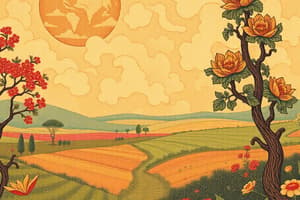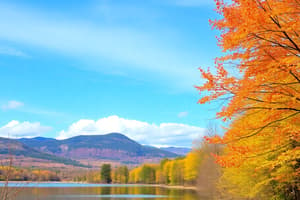Podcast
Questions and Answers
What event marks the beginning of winter in the Northern Hemisphere?
What event marks the beginning of winter in the Northern Hemisphere?
- Vernal equinox
- Summer solstice
- Autumnal equinox
- Winter solstice (correct)
The four seasons in the Northern Hemisphere are the same as those in the Southern Hemisphere.
The four seasons in the Northern Hemisphere are the same as those in the Southern Hemisphere.
False (B)
What is the longest day of the year in the Northern Hemisphere called?
What is the longest day of the year in the Northern Hemisphere called?
Summer solstice
In the Northern Hemisphere, spring begins on the __________ equinox.
In the Northern Hemisphere, spring begins on the __________ equinox.
Match the seasons with their corresponding characteristics:
Match the seasons with their corresponding characteristics:
Which season is characterized by the most hours of daylight in the Northern Hemisphere?
Which season is characterized by the most hours of daylight in the Northern Hemisphere?
The vernal equinox occurs in September.
The vernal equinox occurs in September.
What causes the seasons to change throughout the year?
What causes the seasons to change throughout the year?
What is the primary reason for variations in daylight hours in mid-latitude regions?
What is the primary reason for variations in daylight hours in mid-latitude regions?
Athens, Greece, experiences less variation in daylight hours compared to Helsinki, Finland.
Athens, Greece, experiences less variation in daylight hours compared to Helsinki, Finland.
How many hours of daylight does Helsinki, Finland, experience in the middle of June?
How many hours of daylight does Helsinki, Finland, experience in the middle of June?
Near the Equator, regions typically have alternating _____ and dry seasons.
Near the Equator, regions typically have alternating _____ and dry seasons.
Match the following locations with their characteristics regarding daylight variation:
Match the following locations with their characteristics regarding daylight variation:
What happens to the amount of daylight in Barrow, Alaska between mid-May and early August?
What happens to the amount of daylight in Barrow, Alaska between mid-May and early August?
Flashcards are hidden until you start studying
Study Notes
Seasons Overview
- Seasons are defined by distinct climate conditions: spring, summer, fall (autumn), and winter.
- Each season has unique light, temperature, and weather patterns that recur annually.
Seasonal Dates in the Northern Hemisphere
- Winter begins around December 21 or 22, known as the winter solstice – shortest daylight.
- Summer starts on June 20 or 21, the summer solstice – longest daylight.
- Spring equinox occurs on March 20 or 21, with equal daylight and darkness.
- Autumnal equinox is on September 22 or 23, also featuring equal amounts of daylight and darkness.
Seasonal Opposites
- Seasonal patterns in the Northern Hemisphere oppose those in the Southern Hemisphere.
- For example, winter in Argentina and Australia starts in June.
Earth's Axis and Sunlight
- Seasons arise from Earth's axial tilt relative to its orbital plane.
- Earth’s axis is an imaginary line running from pole to pole, influencing rotation and sunlight distribution.
- Northern Hemisphere receives more sunlight and longer days in June, contrasting with fewer daylight hours in December.
Impact on Vegetation
- Seasons significantly affect plant growth and vegetation cycles:
- Winter: Cold, limited daylight, slow or no plant growth.
- Spring: Active growth; plants sprout and flowers bloom.
- Summer: Warmest season with maximum daylight; plants thrive.
- Autumn: Temperature drops, many trees shed leaves.
Seasonal Variation by Latitude
- Four-season cycles are characteristic of mid-latitudes, not typical near the poles or equator.
- As latitude increases, seasonal differences become more pronounced:
- Helsinki, Finland: 18.5 hours of daylight in June, less than six hours in December.
- Athens, Greece: 14.5 hours in June, 9.5 hours in December.
Equatorial and Polar Regions
- Equatorial regions experience minimal seasonal variation, maintaining consistent warm temperatures year-round, often with alternating rainy and dry seasons.
- Polar regions undergo extreme seasonal variations, with places like Barrow, Alaska:
- Continuous daylight from mid-May to early August.
- Complete darkness from mid-November to January.
Studying That Suits You
Use AI to generate personalized quizzes and flashcards to suit your learning preferences.




